
Robinia is a genus of flowering plants in the family Fabaceae, tribe Robinieae, native to North America. Commonly known as locusts, they are deciduous trees and shrubs growing 4–25 metres (13–82 ft) tall. The leaves are pinnate with 7–21 oval leaflets. The flowers are white or pink, in usually pendulous racemes. Many species have thorny shoots, and several have sticky hairs on the shoots.

Inula is a genus of about 80 species of flowering plants in the family Asteraceae, native to Europe, Asia and Africa.
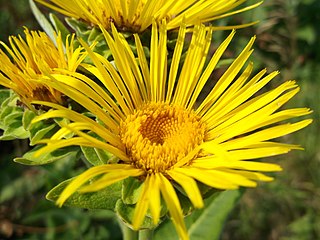
Elecampane, pronounced and also called horse-heal or elfdock, is a widespread plant species in the sunflower family Asteraceae. It is native to Eurasia from Spain to Xinjiang province in western China, and naturalized in parts of North America.
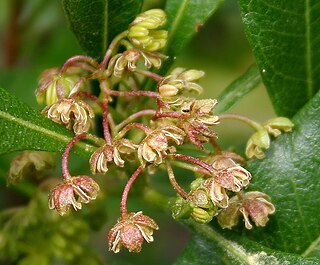
Dodonaea viscosa, also known as the broadleaf hopbush, is a species of flowering plant in the Dodonaea (hopbush) genus that has a cosmopolitan distribution in tropical, subtropical and warm temperate regions of Africa, the Americas, southern Asia and Australasia. Dodonaea is part of Sapindaceae, the soapberry family.

Dittrichia is a genus of flowering plants in the daisy family. Its species were formerly included in the genus Inula.
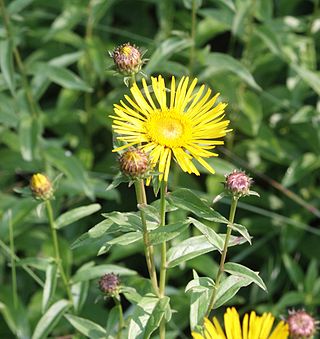
Pentanema salicinum is a plant species in the family Asteraceae. It is found across Eurasia from Portugal to Japan. It has been reported growing in the wild in a few scattered locations in North America but it has not become widely established there.
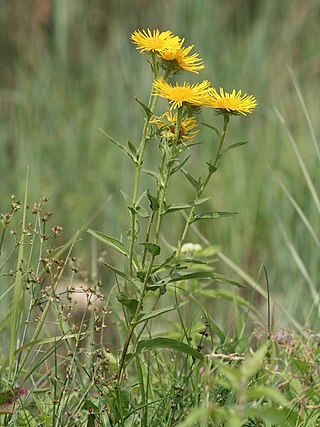
Pentanema britannica, the British yellowhead or meadow fleabane, is a Eurasian species of plant in the daisy family. It is widespread across much of Europe and Asia, and sparingly naturalized in scattered locations in North America.

Hellinsia osteodactyla is a moth of the family Pterophoridae. It is found in most of Europe, as well as North Africa and from Asia Minor to Japan. Also known as the small golden-rod plume it was first described by Philipp Christoph Zeller in 1841.

Hellinsia is a genus of moths in the family Pterophoridae. It was created by J.W. Tutt in honour of the entomologist John Hellins.

Dittrichia viscosa, also known as false yellowhead, woody fleabane, sticky fleabane and yellow fleabane, is a flowering plant in the daisy family.

Hellinsia carphodactyla is a moth of the family Pterophoridae, first described by Jacob Hübner in 1813. It is known from most of Europe, Asia Minor and North Africa.
Coleophora inulae is a moth of the family Coleophoridae. It is found from Finland to the Pyrenees, Italy and Bulgaria and from Great Britain to southern Russia.
Coleophora jerusalemella is a moth of the family Coleophoridae. It is found in Spain, Greece, on Crete and Cyprus and in Algeria, Lebanon, the Palestinian Territories, Syria, Saudi Arabia, Oman, Iran, Jordan and the United Arab Emirates.
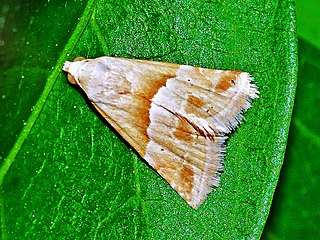
Eublemma parva, the small marbled, is a moth of the family Erebidae. The species was first described by Jacob Hübner in 1808.
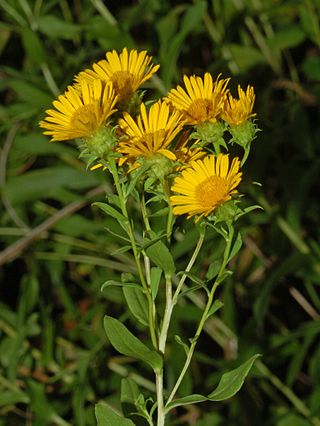
Pentanema spiraeifolium is a species perennial herbaceous plant belonging to the family Asteraceae. It is found from Europe to Iran.

Hellinsia pectodactylus is a moth of the family Pterophoridae. It is found in Europe, the Canary Islands, Kyrgyzstan, Afghanistan, India and North America.
Oidaematophorus constanti is a moth of the family Pterophoridae. It is found on Corsica and Sardinia and in Spain, France, Germany, the Czech Republic, Austria, Slovenia, Slovakia, Hungary, Romania and North Macedonia.

Condica viscosa is a moth of the family Noctuidae. It was described by Christian Friedrich Freyer in 1831. It is found from southern Europe and North Africa to Arabia and the southern parts of western Asia. The habitat consists of lowland areas near the coast, including dry slopes, road side verges, dry river beds or fallow land.

Cleome viscosa, the Asian spiderflower or tick weed is an annual herb that grows up to a meter high. It belongs to the family Cleomaceae. It is considered an invasive species and is widely distributed in warm and humid habitats across the Americas, Africa and Asia, and in Australia. It is commonly found during the rainy season.













